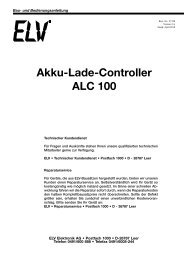Akku-Lade-Center Battery Charging Centre ALC 8500-2 ... - Batimex
Akku-Lade-Center Battery Charging Centre ALC 8500-2 ... - Batimex
Akku-Lade-Center Battery Charging Centre ALC 8500-2 ... - Batimex
Erfolgreiche ePaper selbst erstellen
Machen Sie aus Ihren PDF Publikationen ein blätterbares Flipbook mit unserer einzigartigen Google optimierten e-Paper Software.
7 Lead-acid activator (reviver) function<br />
The <strong>ALC</strong> <strong>8500</strong>-2 Expert features a lead-acid activator function which can be selected when charging<br />
a lead-acid battery at channel 2. This function eliminates the problem of crystalline sulphate deposits<br />
on the plates of lead-acid batteries which have not been used for a long time, or are only ever discharged<br />
at low currents when in use.<br />
Lead-acid batteries are designed to provide a useful life of eight to ten years or more, provided that<br />
they are maintained properly. However, in practice they very rarely last this long, and in fact the average<br />
useful life of a lead-acid battery is generally far below the theoretical maximum. A particular problem<br />
is the lead-acid battery which is only used seasonally; these regularly fail prematurely.<br />
Many owners of motorcycles, boats and ride-on lawnmowers will be all too familiar with this problem:<br />
in the Spring the expensive battery fails the first time it is called upon, and has to be replaced. The<br />
formation of sulphate deposits is fundamental to lead-acid batteries, but the problem is particularly<br />
severe when they are slowly discharged, e.g. when they self-discharge under storage conditions; the<br />
result is a covering of crystalline sulphates all over the lead plates. The thicker the deposits become,<br />
the less energy the battery can store, and - of course - the less it can deliver. At higher ambient temperatures<br />
the rate of sulphate build-up rises considerably. Sulphate deposits are the primary reason<br />
for the premature failure of lead-acid batteries.<br />
The Activator function can be set to switch in automatically if desired, as soon as the <strong>ALC</strong> <strong>8500</strong>-2<br />
Expert switches to trickle charge mode when charging a lead-acid battery<br />
Periodic pulses of peak current prevent the build-up of sulphate deposits on the lead plates. The<br />
process also dissolves existing sulphate deposits, and the material is re-absorbed into the battery<br />
fluid in the form of active sulphur molecules.<br />
Although the pulses of current are high, relatively little energy is removed from the battery, as the<br />
duration of the discharge current pulses, which occur every 30 seconds, is only 100 micro-seconds.<br />
The trickle charge process soon compensates for the energy discharge.<br />
The BA function works at battery voltages of up to 15 V.<br />
The discharge pulse is indicated by an LED on the front panel (next to the channel 2 LED); this enables<br />
you to check that the process is in action. The LED indicates the actual current flow, allowing you<br />
to monitor the operation of the circuit.<br />
40



